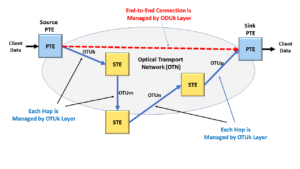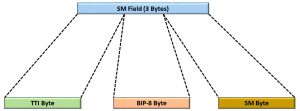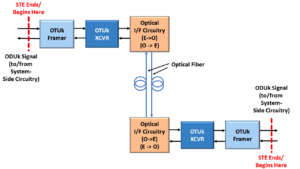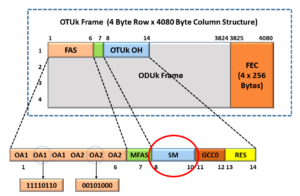What is Section Terminating Equipment (STE) for OTN Applications?
Whenever we discuss the OTN Digital Layers (e.g., the OPUk, ODUk, and OTUk layers), we can group Networking Circuits and Equipment into one of two broad categories.
- STE – Section Terminating Equipment and
- PTE – Path Terminating Equipment
I will be using these terms throughout various OTN-related posts within this blog. So, we must have a strong understanding of these terms.
I have devoted this blog post to STE (Section Terminating Equipment).
I have devoted another post to PTE (Path Terminating Equipment).
NOTE: I discuss STEs and PTEs extensively in Lesson 3 within THE BEST DARN OTN TRAINING PRESENTATION….PERIOD!!! I also discuss the differences between STEs and PTEs as well.
What is a Section?
Before we define the term Section Terminating Equipment (or STE), we must first define the word Section as it pertains to an Optical Transport Network (OTN).
For OTN applications, a Section is a single optical link (or span) between two adjacent pieces of networking equipment.
NOTE: For lower speed applications, one can realize a Section via a Copper Medium (such as CAT5 or CAT6 Cable).
Figure 1 presents a simple illustration of an Optical Transport Network with some boxes labeled PTE and others labeled STE.

Figure 1 illustrates STE (Section Terminating Equipment) and PTE (Path Terminating Equipment). Note: Figure 1 shows a total of five (5) different boxes.
Two of these boxes are labeled PTE, and three of these boxes are labeled STE.
However, in reality, all 5 of these boxes are STEs.
From a system standpoint, many PTEs are STEs. However, not all STEs are PTEs.
We can also define a Section as any optical connections connecting these boxes (in Figure 1).
Now, we will define the term Section Terminating Equipment.
What is an STE (Section Terminating Equipment)?
For OTN applications, the basic definition of a Section Terminating Equipment is any equipment that (1) transmits data into or receives data from the Section and (2) also monitors and manages the data transmission over this Section (e.g., the optical fiber link that exists between the Near-End and the adjacent Far-End Network Equipment).
For OTN applications, the OTUk Layer is the protocol layer responsible for managing and monitoring the transmission/reception of data across a Section.
More specifically, an OTN Source (or Transmitting) STE is any equipment that performs ALL the following functions.
The Source STE Operation In the Transmit Direction
- It will accept data from upstream circuitry (typically in the form of ODUk frames).
- It electrically preconditions all data (that it is about to transmit to the remote Sink STE via an optical connection) by computing and attaching the OTUk (or OTUkV) overhead to this data stream. This data will typically (but not always) include the FEC.
- Once the Source STE has finished preconditioning this data, it will convert this electrical data into the optical format and transmit it over optical fiber to the remote Sink STE.
Sink STE Operation In the Receive Direction
The Sink (Receiving) STE performs all of the following operations.
- It receives data (from a remote Source STE) in the optical format.
- The Sink STE then converts this optical data into the electrical format, where it can check and process these newly received OTUk/OTUkV frames.
As the Sink STE checks and processes this data, it will check for the following items. - It will then pass this data to the downstream circuitry as an ODUk data stream (for further processing at the ODUk-layer).
Therefore, if we were to combine our simple definition of the word Section with the description of a Section Terminating Equipment, we can say the following.
Summarizing our Definitions of Section and STE
An STE begins at the point where the Network Equipment (or the Source STE) will precondition and process electrical data in preparation for transmission over an Optical link.
Afterward, the Source STE will convert this signal into the Optical Format, transmitting this optical signal to the remote Sink (or Receiving) STE.
A Section ends (or is terminated) at the point where the Sink STE (that receives this optical signal) converts it back into the electrical format, processes this data, and sends it to downstream equipment.
How the STE Operates in the Optical Transport Network (OTN)
A Source STE will manage and monitor the transmission of this data (across a Section) by encapsulating this data into OTUk/OTUkV frames.
This Source STE will encapsulate this (ODUk) data by generating and inserting some overhead data (that we call the OTUk-SMOH [Section Monitoring Overhead]) into these OTUk/OTUkV frames.
NOTE: In some of my other posts, I refer to this Source (or Transmitting) STE as the OTUk/ODUk_A_So, OTUk_TT_So, and OTSi/OTUk_A_S0 or OTSiG/OTUk_A_So atomic functions.
The Sink (or Receiving) STE will use this OTUk-SMOH to manage data reception across the Section.
NOTE: In my other posts, I also refer to this Sink (or Receiving) STE as the OTUk/ODUk_A_Sk, OTUk_TT_Sk, and OTSi/OTUk_A_Sk or OTSiG/OTUk_A_Sk atomic functions.
The STE STE will manage the reception of data across the Section by using this OTUk-SMOH to check for data transmission errors and service-affecting defects.
What is the OTUk-SMOH (Section Monitoring Overhead)?
But when we say “OTUk-SMOH,” what exactly do we mean?
Figure 2 illustrates the OTUk Overhead data (within an OTUk frame) that the Section Terminating Equipment will process and terminate as it manages data transmission across a Section.
This figure also highlights a particular field (regarding Section Monitoring). This figure highlights the Section Monitoring field.

Figure 2, Illustration of an OTUk Frame with the OTUk SMOH Fields highlighted
I highlight the SM (or Section Monitoring) field because the actual OTUk-SMOH (that the Sink STE will use to check for the presence of defects or errors) resides within the Section Monitoring (or SM) field (within the OTUk Overhead).
In Figure 3, I focus on the Section Monitoring field and illustrate the byte format of this 3-byte field.

Figure 3, Illustration of the Byte-Format of the Section Monitoring field.
Figure 3 shows that the Section Monitoring field contains the following three byte-fields.
- The BIP-8 Byte
- The TTI Byte and
- The Section Monitoring (or SM) Byte
In Figure 4, I further focus on the SM Byte and show the bit format of that particular byte field.

Figure 4, Bit-Format of the SM (Section Monitoring) Byte – within the Section Monitoring field
If you have seen the OTUk Frame post, Figures 2 through 4 should look familiar.
All of the overheads fields that the Sink STE will need to check for OTUk-related defects and errors (not including FEC) reside within the SM field.
Hence, the OTUk-SMOH is the Section Monitoring field within the OTUk Overhead.
NOTE: For “nuts and bolts” details on the Source and Sink STEs handling and processing the OTUk-SMOH, check out the posts on the following Atomic Functions.
- For the Source STE
- OTUk/ODUk_A_So – OTUk to ODUk Adaptation Source Function
- OTUk_TT_So – OTUk Trace Termination Source Function
- OTSi/OTUk_A_So – OTSi to OTUk Adaptation Source Function (Single-Lane Applications)
- OTSiG/OTUk_A_So – OTSiG to OTUk Adaptation Source Function (Multi-Lane OTU3/OTU4 Applications)
- For the Sink STE
- OTUk_TT_Sk – OTUk Trace Terminating Sink Function
- OTUk/ODUk_A_Sk – OTUk to ODUk Adaptation Sink Function
- OTSi/OTUk_A_Sk – OTSi to OTUk Adaptation Sink Function (Single-Lane Applications)
- OTSiG/OTUk_A_Sk – OTSiG to OTUk Adaptation Sink Function (Multi-Lane OTU3/OTU4 Applications)
Now let’s proceed to show an example of STE and its Section.
AN EXAMPLE OF AN STE AND ITS SECTION
Figure 5 illustrates an STE and Section within a typical OTN network connection.

Figure 5, Illustration of the STE and Section (from End to End) in a Typical OTN System
Finally, Figure 5 shows that the Section and STE begin (and end) before and after the OTUk Framer Block.
Please note that the STE also includes the OTUk Framer blocks in this Figure.
The OTUk Framer Blocks (and, in some cases, the OTUk Transceiver Blocks) are responsible for generating and inserting the OTUk-SMOH into the outbound OTUk data stream.
These same functional blocks are also responsible for processing and terminating the OTUk-SMOH within the incoming OTUk data stream.
Throughout numerous blog posts, we discuss the generation and processing of the OTUk-SMOH in detail.
Examples of STE
The following is a list of examples of the various types of OTN STE that are being deployed into the network infrastructure today.
- Any 3R type of repeater.
- Any network element that takes electrical data and maps it into an OTUk signal for transport to another terminal over an optical (or copper) connection (e.g., equipment that transmits data through sub-marine links, etc.).
- CFP Optical Modules that also contains the DSP Transceiver.
- Line Cards that include CFP2/CFP4 Optical Modules and OTN Framers.
Has Inflation got You Down? Our Price Discounts Can Help You Beat Inflation and Help You Become an Expert on OTN!! Click on the Banner Below to Learn More!!!
Discounts Available for a Short Time!!
For More Information on OTN Posts in this Blog, click on the Image below.




 Figure 1, Illustration of that portion of the OTUk frame, which the OTUk_TT_So function will use for the Section Monitoring BIP-8 Calculation
Figure 1, Illustration of that portion of the OTUk frame, which the OTUk_TT_So function will use for the Section Monitoring BIP-8 Calculation 











